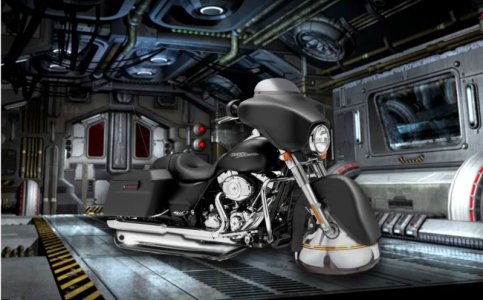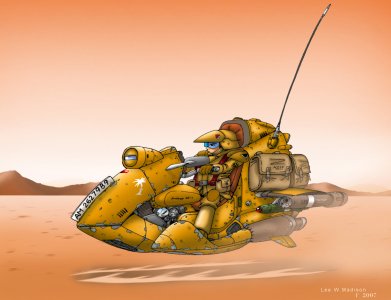though I've wondered if the generated grav field is always proportional to the local gravity. That is, the higher the local gravity is, the stronger the generated reaction force is. So that you will always get the same acceleration regardless of local gravity. Of course, this does have odd effects at extreme ranges: black holes, for instanceProblem is, if it is one, is that local gravity fields vary.
And fractional gravities, whether on gravitational motors, lifters, or manoeuvre drive, need to be tuned to that field, usually in the Mars to Terra range.
You are using an out of date browser. It may not display this or other websites correctly.
You should upgrade or use an alternative browser.
You should upgrade or use an alternative browser.
What does your grav bike look like?
- Thread starter whartung
- Start date
Spinward Flow
SOC-14 5K
Simplest solution to the "problem" is that anti-grav works based on Mass, not on Weight.though I've wondered if the generated grav field is always proportional to the local gravity. That is, the higher the local gravity is, the stronger the generated reaction force is. So that you will always get the same acceleration regardless of local gravity. Of course, this does have odd effects at extreme ranges: black holes, for instanceBut it was a thought so I did not have to worry about localized tuning of grav engines.
That way, anti-grav propulsion/thrust will achieve the same acceleration of a given rest mass regardless of the local gravity field conditions.
For gaming purposes, that means that if you can get a performance of 10m/s2 acceleration under world gravity well conditions of 1G (Terra nominal) ... then you'll STILL get that same performance of 10m/s2 acceleration yield under different local gravity conditions (Luna, Mars, etc.). The difference is that in lower gravity conditions, you need to "spend" less of your anti-grav thrust vector on "lift" to maintain buoyancy/altitude over surface and have more "thrust" fraction left over for lateral movement/travel.
Nightwind1
SOC-12
Rob Caswell for the win!I figure it's pretty similar to this:
View attachment 6248
EDIT: I thought it would put a picture up.
MOD EDIT: Image Inserted
The way I see it, using TNE/FF&S's assumption that contra-grav neutralises about 99% of gravitational attraction, a fully loaded grav bike massing about 1.4 tonnes (TNE's numbers) thus weighs about 14 kg on Earth. It displaces about 1.4kg of air so it's not buoyant, but it takes only a little vertical thrust or aerodynamic lift to allow it to fly. Given the TNE grav bike has a 700kg HEPlaR thruster (don't stand behind it!), the biggest issue is probably running the thing at low enough power to just hover (well, aside from how the C-G system is allowing perpetual motion machines and smashing the Laws of Thermodynamics into little itty bits).
That's the fundamental issue.Given the TNE grav bike has a 700kg HEPlaR thruster (don't stand behind it!)
Making these devices safe for civilized life.
You still need acceleration to counter the actual mass of the vehicle, regardless of how hard gravity is tugging on it
You can get by with less, but if it's a thruster of any kind, there's going to be, well, thrust to deal with. Especially if it's fusion out gassing by products.
Modern gas and electric vehicles do require external thrust, relying on traction and radiators for the waste heat. But, they don't fly either.
That earlier drawing of the Flying Brookstick with the pivoting fans is probably about as sane and you're going to get, but I bet what they lack in "blasting nearby pedestrians off their feet" power, they make up for in just raw noise.
As shrouded props they'll be less noisy than just most other methods, but at full power they're probably not quiet.That earlier drawing of the Flying Brookstick with the pivoting fans is probably about as sane and you're going to get, but I bet what they lack in "blasting nearby pedestrians off their feet" power, they make up for in just raw noise.
kilemall
SOC-14 5K
That’s how CT Striker operates.Simplest solution to the "problem" is that anti-grav works based on Mass, not on Weight.
That way, anti-grav propulsion/thrust will achieve the same acceleration of a given rest mass regardless of the local gravity field conditions.
For gaming purposes, that means that if you can get a performance of 10m/s2 acceleration under world gravity well conditions of 1G (Terra nominal) ... then you'll STILL get that same performance of 10m/s2 acceleration yield under different local gravity conditions (Luna, Mars, etc.). The difference is that in lower gravity conditions, you need to "spend" less of your anti-grav thrust vector on "lift" to maintain buoyancy/altitude over surface and have more "thrust" fraction left over for lateral movement/travel.
Condottiere
SOC-14 5K
There are many likely solutions.
But, I think it might be layered.
You have two types of gravitational motors installed.
The lifters neutralize the local gravity field.
Then, you have separate thrusters that give acceleration and direction.
But, I think it might be layered.
You have two types of gravitational motors installed.
The lifters neutralize the local gravity field.
Then, you have separate thrusters that give acceleration and direction.
Problem is, if it is one, is that local gravity fields vary.
And fractional gravities, whether on gravitational motors, lifters, or manoeuvre drive, need to be tuned to that field, usually in the Mars to Terra range.
That's what I was talking about. The early (in publication history) version of grav vehicles worked exactly that way, if only because they hadn't really thought about it that much.though I've wondered if the generated grav field is always proportional to the local gravity. That is, the higher the local gravity is, the stronger the generated reaction force is. So that you will always get the same acceleration regardless of local gravity. Of course, this does have odd effects at extreme ranges: black holes, for instanceBut it was a thought so I did not have to worry about localized tuning of grav engines.
Striker and so forth are what they ended up with when they did put some thought into it. Unfortunately, backporting Striker's design sequence onto LBB2-3 vehicles yeilds quirky results.
BlackBat242
SOC-14 1K
As I do my thinking about these things using FF&S, I assume contra-grav produces no thrust. It just makes everything in a field (either a simple ellipsoid shape or one bounded by a sealed hull) weigh very little (though mass is retained). So alternate sources of thrust and directional control are required to move and to control direction and attitude.
As for what they look like - it depends on manufacturer and exact intended role. Some look like the 'IISS Grav Bike' image above. Others like:
View attachment 6245
And, for a more radical appearance, some are the 'broomsticks' of the Reformation Coalition:
View attachment 6246
Or this (made by a venerable Terran firm):

Chris Barlow
SOC-10
What does my grav bike look like? IMTU like it was bought seco d hand from Judge Dreed.
So, this is a marvelous, completely impractical flying machine demonstration. Someone bolted a seat to a jet engine. It's a wonderful demonstration of where automated control is at.
The key issue here is simply the exhaust from the jet. This thing is riding on the thrust from the jet. There's no lift of any kind here, and it's clearly doing a lot of work. As you can see from the debris this kicks up, this isn't going to be near people (or much anything else) at any point in the future. (We won't go into the sounds and such of this machine.)
But it brings up how grav vehicles work in Traveller.
in CT, there's not a lot of detail how AG works. Is there a "gravity force vector" pushing against the gravity of the planet? But how does the residual of that force work? If you're flying around in an air/raft, is there any external effect? Air pushed aside? Dust kicked up? Objects in the gravity field also adopt the AG force vector? Like, maybe as the air/raft is flying, may it collects a cloud of debris. Papers, plastic cups, maybe rocks or whatever, all things that happen to be in the AG field, adopting "AG" properties.
Then there's TNE, with contra-grav. Here, it negates the effect of gravity, negates its pull. But it's not a thrust (well, it is, it's just fixed). Contra-grav can't "push", it cancels/negates. Like standing behind a wall in the wind. The wall resists the wind, but it's not pushing back, per se. It pushes back "just enough".
So, you can't lift on contra-grav alone. You still need an external force to move the vehicle. But you don't need as much. Specifically, contra-grav eliminates (mostly) the "friction" of gravity. You still need 1G of thrust (based on your weight), but you just need it for an instant to get moving. But you will also need 1/100G to maintain that movement (or I should say to counteract the G vector). Because CG reduces gravity 99%.
Back this this jet bike, we can hand wave and say that it weighs 200kg with the rider. That suggest 2kg of downforce thrust to keep it up. Not a whole lot.
But a loaded Free Trader? At 2000 tons, 2Mkg. 20,000kg of force to keep it aloft. Now a Free Trader is roughly 280m in area, so that about .7kg of force per cm^2. THAT isn't too awful. But person, at, say, 2m x .6m, 1200 cm^2, thats 840 kg. I don't think I'd want to be underneath that ship when it took off.
An Air/raft, at 4 tons, 4000kg, 40kg to keep it aloft. Not bad, I wouldn't want it running over my foot. I wonder how close to the front door one of these could land. Because it's going to take more force to slow it down.
Condottiere
SOC-14 5K
Condottiere
SOC-14 5K
1. Judge Dree.
2. What's underneath it?
2. What's underneath it?
Spinward Flow
SOC-14 5K
-duh, tainted atmosphereTainted atmosphere.
Duh
Don't touch me, please
I cannot stand the way you teeeease....
Which basically looks like a snowmobile/snow-machine/Ski-Doo® minus the skis. And like an aquabike/sea-doo.
And is pretty much how they've looked in my traveller games over the years.
Now, in Star Wars....
Condottiere
SOC-14 5K
I remember when I had a go at it, I thought, big windscreen, especially once you start gunning the engine.
Similar threads
- Replies
- 51
- Views
- 3K
- Replies
- 191
- Views
- 15K



